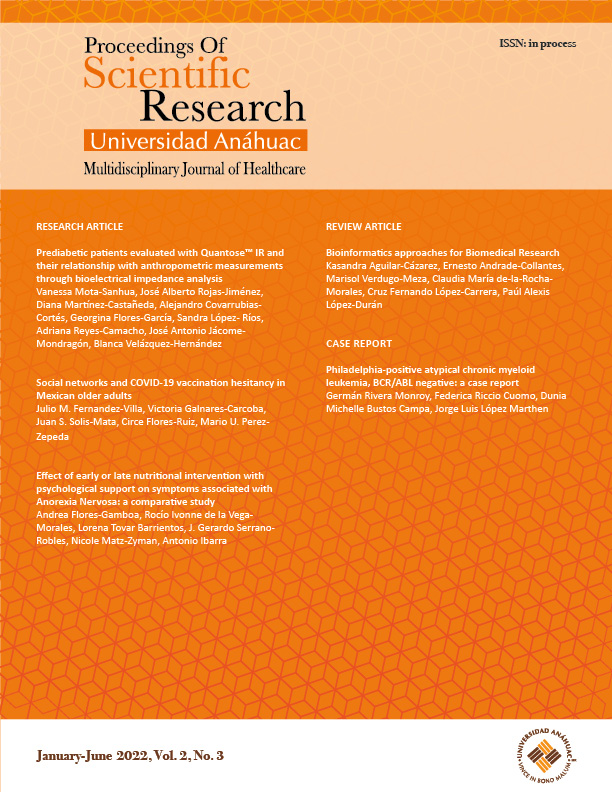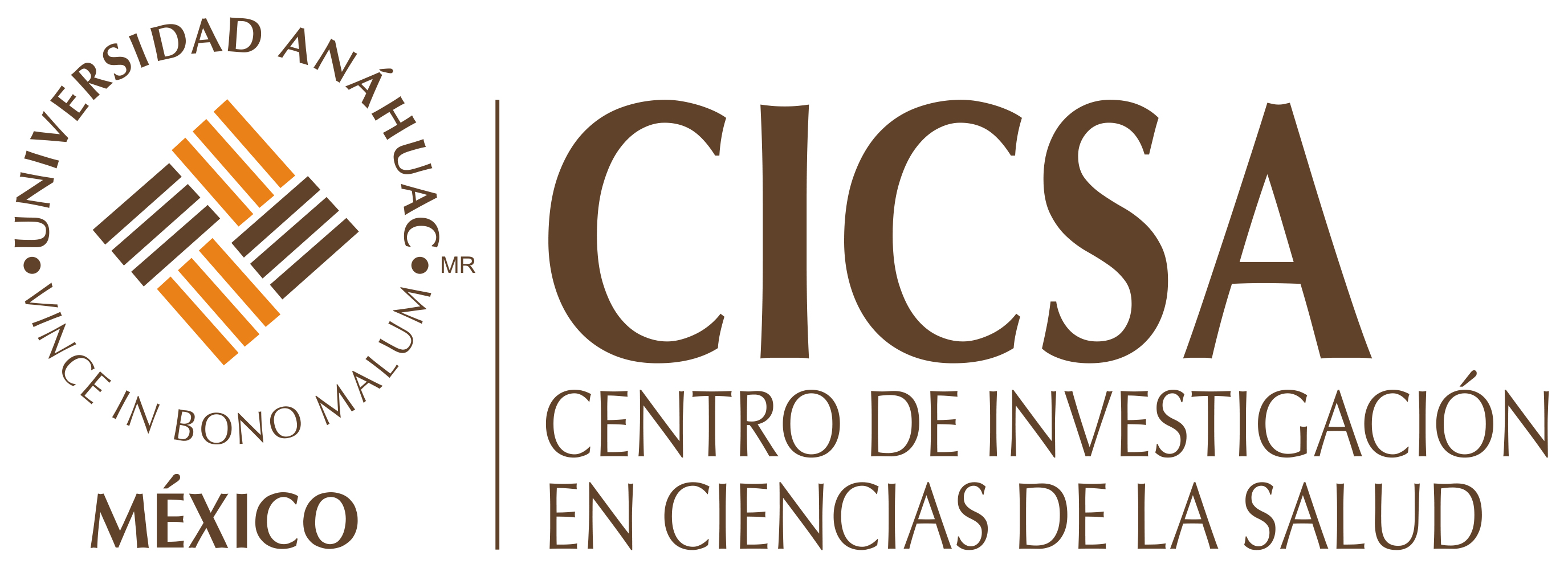Effect of early or late nutritional intervention with psychological support on symptoms associated with Anorexia Nervosa: a comparative study
DOI:
https://doi.org/10.36105/psrua.2022v2n3.03Palabras clave:
anorexia nerviosa, desorden nutricional, psicología, intervención temprana, intervención tardíaResumen
Introduction: Anorexia nervosa (AN) is a disease with increasing incidence and prevalence, favored by biological, psychological, familial, and social factors. Management must be interdisciplinary, involving the intervention of nutritionists and psychologists. Additionally, it is important to evaluate the effect of an early or a late onset of the intervention. Objective: To determine if early nutrition-based intervention along with psychological support leads to a decrease in the symptoms associated with Anorexia Nervosa, when compared with late intervention. Methods: To evaluate the above parameters, an exploratory study was proposed with a design of non-randomized clinical trial and a non-probability purposive sampling of n = 17 women with AN between 12 and 25 years of age (x̄ = 16.8 ± 3.6). According to the moment of the nutritional intervention with psychological support, the 17 women were divided into two groups: Group 1 (n = 10) start the intervention in the first six months after the onset of the disease while Group 2 (n = 7) started 3 years after the disease. The nutritional and psychological carried out consisted of three phases: individualized nutritional assessment, design of the meal plan according to the metabolic needs of each patient and nutritional indications, and an individualized psychological intervention. Both interventions were carried out once a week for six months, for a total of 24 psychological and nutritional sessions. The physical variables of body mass index (BMI) and arm muscle area (AMA) were measured. To assess emotional changes, the body image dissatisfaction subscale of the Eating Disorder Inventory (EDI) was used. Results: Six months after follow-up, the results showed statistically significant changes in the BMI (p <,0.01), AMA (p <,0.01) and body image dissatisfaction (p <,0.01) after the intervention. It was found that the early-intervention group presented lower values in BMI and AMA as compared to the late-intervention patients while both groups showed a marked reduction in body image dissatisfaction values. The late-intervention group presented the sharpest reduction. There was no significant difference in the variables BMI and AMA in the intragroup comparisons. Conclusion: The early-onset nutritional intervention with psychological support decreased the physical and emotional symptoms associated with AN.
Descargas
Referencias
Smink FRE, Van Hoeken D, Oldehinkel AJ, Hoek HW. Prevalence and severity of DSM-5 eating disorders in a community cohort of adolescents. Int J Eat Disord. 2014;47(6):610–9. https://doi.org/10.1002/eat.22316
Zipfel S, Giel KE, Bulik CM, Hay P, Schmidt U. Anorexia nervosa: Aetiology, assessment, and treatment. The Lancet Psychiatry [Internet]. 2015;2(12):1099 111. Available from: http://dx.doi.org/10.1016/S2215-0366(15)00356-9
Anorexia Nervosa - MeSH - NCBI [Internet]. [cited 2020 Sep 10]. Available from: https://www.ncbi.nlm.nih.gov/mesh?term=Anorexia+Nervosa
Pediatría TO, Zaragoza-cortes J, Trejo-osti LE, Ocampo-torres M, Maldonado-vargas L, Ortiz-gress AA. Consenso sobre la evaluación y el tratamiento nutricional de los trastornos de la conducta. Poor breastfeeding, Complement Feed Diet Divers Child their Relatsh with stunting Rural communities. 2018;35:1–8.
Santoncini CU, Romo AC. Guía clínica para trastornos de la conducta alimentaria [Internet]. Guias Clinicas Para La Atencion De Trantornos Mentales. 2010. 1–46 p. Available from: http://www.inprf.gob.mx/opencms/export/sites/INPRFM/psicosociales/archivos/guias/trastornos_alimentacion.pdf
Hay P, Chinn D, Forbes D, Madden S, Newton R, Sugenor L, et al. Royal Australian and New Zealand College of Psychiatrists clinical practice guidelines for the treatment of eating disorders. Aust N Z J Psychiatry. 2014;48(11):977–1008. https://doi.org/10.1177/0004867414555814
Weaver L, Sit L, Liebman R. Treatment of anorexia nervosa In children and adolescents. Curr Psychiatry Rep. 2012;14(2):96–100. https://doi.org/10.1007/s11920-012-0257-z
Gowers SG, Clark A, Roberts C, Griffiths A, Edwards V, Bryan C, et al. Clinical effectiveness of treatments for anorexia nervosa in adolescents: Randomised controlled trial. Br J Psychiatry. 2007;191(NOV.):427–35. https://doi.org/10.1192/bjp.bp.107.036764
Pj H, Touyz S, Am C, Lujic S, Ca S, Madden S. Inpatient versus outpatient care, partial hospitalisation and waiting list for people witheating disorders (Review). Cochrane Libr. 2019;(1):76. https://doi.org/10.1002/14651858.CD010827.pub2
Hughes EK, Sawyer SM, Accurso EC, Singh S, Le Grange D. Predictors of early response in conjoint and separated models of family-based treatment for adolescent anorexia nervosa. Eur Eat Disord Rev. 2019;27(3):283–94. https://doi.org/10.1002/erv.2668
Madden S, Miskovic-Wheatley J, Wallis A, Kohn M, Hay P, Touyz S. Early weight gain in family-based treatment predicts greater weight gain and remission at the end of treatment and remission at 12-month follow-up in adolescent anorexia nervosa. Int J Eat Disord. 2015;48(7):919–22. https://doi.org/10.1002/eat.22414
Fisher CA, Skocic S, Rutherford KA, Hetrick SE. Family therapy approaches for anorexia Nervosa. Cochrane Database Syst Rev. 2019;2019(5). https://doi.org/ 10.1002/14651858.CD004780.pub3
Heshmatpour M. Bell inequalities for arbitrary situations. Phys Lett Sect A Gen At Solid State Phys. 2015;379(10–11):870–2.
Boraska V, Franklin CS, Floyd JAB, Thornton LM, Huckins LM, Southam L, et al. A genome-wide association study of anorexia nervosa. Mol Psychiatry. 2014;19(10):1085–94. http://doi.org/10.1038/mp.2013.187
Scalfi L, Polito A, Bianchi L, Marra M, Caldara A, Nicolai E, et al. Body composition changes in patients with anorexia nervosa after complete weight recovery. Eur J Clin Nutr. 2002;56(1):15–20. http://doi.org/10.1038/sj.ejcn.1601290
Golden NH, Jacobson MS, Sterling WM, Hertz S. Treatment goal weight in adolescents with anorexia nervosa: Use of BMI percentiles. Int J Eat Disord. 2008;41(4):301–6. http://doir.org/10.1002/eat.20503
Treatments of medical complications of anorexia nervosa and bulimia nervosa. Mehler PS, Krantz M. PHILIP S. MEHLER, M.D., and MORI KRANTZ, M.D. 2003;12(4). http://doi.org/ 10.1186/s40337-015-0041-7
Position of the American Dietetic Association: Nutrition intervention in the treatment of anorexia nervosa, bulimia nervosa, and other eating disorders. J Am Diet Assoc. 2006;106(12):2073–82. http://doi.org/10.1016/j.jada.2006.09.007
Robb AS. Eating disorders in children: Diagnosis and age-specific treatment. Psychiatr Clin North Am. 2001;24(2):259–70. http://doi.org/10.1016/s0193-953x(05)70222-7
Marzola E, Nasser JA, Hashim SA, Shih P an B, Kaye WH. Nutritional rehabilitation in anorexia nervosa: Review of the literature and implications for treatment. BMC Psychiatry. 2013;13. http://doi.org/10.1186/1471-244X-13-290

Descargas
Publicado
Número
Sección
Licencia
Derechos de autor 2022 Andrea Flores-Gamboa, Rocío Ivonne de la Vega-Morales, Lorena Tovar Barrientos, J. Gerardo Serrano-Robles, Nicole Matz-Zyman, Antonio Ibarra

Esta obra está bajo una licencia internacional Creative Commons Atribución-NoComercial-SinDerivadas 4.0.
Todo el contenido intelectual que se encuentra en la presente publicación periódica se licencia al público consumidor bajo la figura de Creative Commons©, salvo que el autor de dicho contenido hubiere pactado en contrario o limitado dicha facultad a “Proceedings of Scientific Research Universidad Anáhuac. Multidisciplinary Journal of Healthcare©” o “Universidad Anáhuac México©” por escrito y expresamente.
Proceedings of Scientific Research Universidad Anáhuac. Multidisciplinary Journal of Healthcare se distribuye bajo una Licencia Creative Commons Reconocimiento-No comercial-Sin derivados 4.0 Internacional (CC BY-NC-ND 4.0).
El autor conserva los derechos patrimoniales sin restricciones y garantiza a la revista el derecho de ser la primera publicación del trabajo. El autor es libre de publicar en cualquier otro medio su artículo, como un repositorio institucional.














